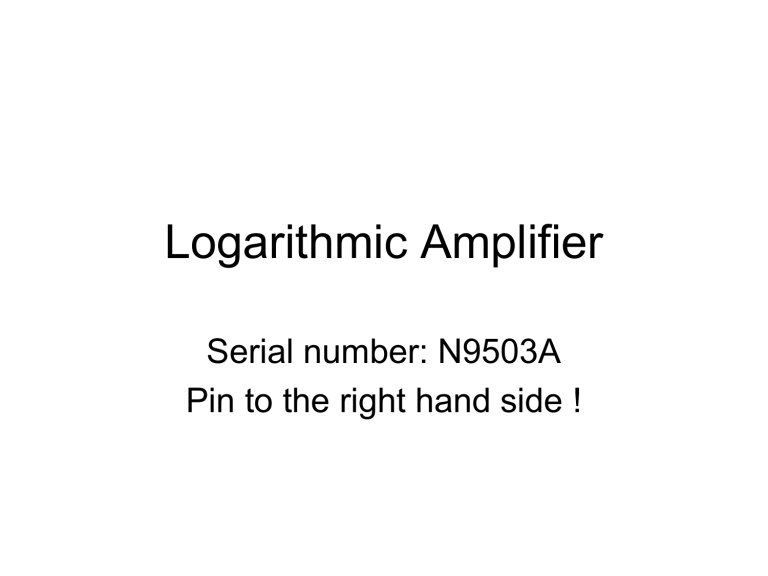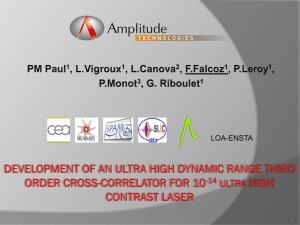Logarithmic Amplifier
advertisement

Logarithmic Amplifier Serial number: N9503A Pin to the right hand side ! General Remarks: 1.) The switch-pin on the amplifier should always be kept to the right when viewed from front If the pin is to the left only very small currents up to ~ 10nA can be measured 2.) The set-point current should be usually kept at 1nA Higher set-point currents have to be calculated from the equations given on the following pages A nominal set point current of 2.5 nA for example corresponds to A real current of ~ 20 mA !!!! 3.) Break-Junction experiments should not be performed at voltages larger than 0.4 V 4.) Do not try to resolve the A Group with it 5.) This head is configured for the old (basement) STM The voltage offset is - 29 mV. To measure at a real tip-voltage of + 0.1 V you choose a voltage of + 0.071 V To measure at a real tip-voltage of – 0.1 V you choose a voltage of - 0.129 V. Calibration Curves using 5 different Resistors 15 KOhm 1 MOhm 10 MOhm 100 MOhm 1 GOhm Tip + 100000 10000 Tip - I / nA 1000 100 10 1 0.1 All calculated current values were corrected for the tunnelling Voltage offset of -29 mV (Old STM) 0.01 1E-3 -3 -2 -1 0 1 2 3 Output Voltage I = abs(Uout) + 10^(abs(Uout)*4.121 - 5.98) 7 10 M / nS at 100 mV 6 10 5 10 G0 4 10 3 10 2 10 1 10 0 10 -1 10 0.0 0.2 0.4 0.6 0.8 1.0 1.2 1.4 1.6 1.8 2.0 2.2 2.4 2.6 2.8 3.0 Uout / V But only if Uout values are spaced equidistant The output signal (Uout) which appears as current in the output file is logarithmic in the range from 10 – 10000 nA where: For Positive tip Voltages: I[nA] = - 10(4.05 (Uout) - 5.83) = - invlog(4.05 (Uout) - 5.83) where Uout is negative (‘nA’); For example Uout = -2 V → log(I) = 2.27 → I = 186 nA Real Current / nA 1000 100 10 -2.2 -2.1 -2.0 -1.9 Output singnal / V -1.8 -1.7 To calculate the output signal for a given conductance (M in nS and U in V): Uout = (log(M × U) + 5.83) / 4.05 10000 Tip Negative (10 - 10000 nA): I[nA] = invlog(-5.90 + 4.08 (Uout)) where Uout is positive 1000 For example Uout = + 2V I / nA log(I) = 2.26 I = 182 nA 100 10 1.7 1.8 1.9 2.0 Uout / V 2.1 2.2 2.3 All Current Results BJ -2 nm to 2 nm; 1s; + 0.2 V; 1 nA 100000 20000 1 mA ( = 65 G0 at 0.2 V) Counts 10000 1000 15000 Counts 100 0 500 1000 1500 2000 2500 3000 3500 Output Signal / 'pA' 10000 5000 0 0 500 1000 1500 2000 2500 Output Signal / 'pA' 3000 3500 All Current Data Histogram - Break Junction - C4DT - + 0.2 V - 1 nA Focus on C - Group 700 600 C1 C2 Counts 500 B1 400 300 200 G0 B2 A1 A2 100 0 1400 1600 1800 2000 2200 2400 2600 'I' / 'pA' Resolution is not very good – C and B group cannot be clearly resolved Linear Amplifier: C4DT +1000 mV focus on small jumps (I < 15 nA): A1: 3.5 nS 700 600 Counts 500 400 300 200 100 0 1 2 3 log(I/pA) 4 5 SMC of HS-(CH2)4-SH Break Junction Method – Linear Amplifier -200 mV Large I = 10 - 100 nA ; C1: 199 nS 1600 Observed Current Window: 10 – 100 nA Counts 1200 A1 800 B1 400 0 1 2 3 4 5 log(I/pA) -200 mV medium (I = 5 - 20) B1: 50 nS 500 Counts Observed Current Window: 5 – 25 nA C1 400 300 200 100 0 1 2 3 4 5 log(I/nA) 150 -200 mV small (I - 0 - 10 nA) A1 4.46 nS Observed Current Window: 0 – 10 nA Counts 100 It is necessary to focus on the relevant current range to resolve the different conductance groups 50 0 1 2 3 log(I/nA) 4 5 Heating and expansion (+ oszillations) at I ~ 1 mA and U = 1 V 8 Cooling and contraction at I ~ 200 nA and U = 1 V 6 z-Voltage 4 2 ~ 200 nm 0 -2 -4 At high I (1mA) and high U (1 V), -6 -100 0 100 200 300 400 500 600 the gap heats up, 700 Current Output / V Time / s 1 measurements are impossible 0 due to current oscillation. -1 200 nA -2 1 mA -3 Shortcut ~ 100 mA -4 -100 0 100 200 300 400 Time / s 500 600 700 6 z - Voltage 4 2 At U = 1 V measurements can be performed up to ~ 10 micro-Ampere 0 -2 -4 Conclusion: -6 0 200 400 600 800 1000 For Break-Junction Experiments at high Time / s Voltages, a current limiting resistor may help to facilitate measurements. 0 Current / V -1 1 nA 10 nA -2 100 nA 1 mA 10 mA Critical Current 100 mA 1 mA -3 -4 0 200 400 600 Time / s 800 1000 Contact Conductance / G0 1000 100 10 -1 0 1 2 3 Penetration Depth / nm 4 5 General Remarks Tip-Sample Distance (s) under various conditions 1000000 100000 G0 -1: dlnI/ds = 10 nm s (10 pA) = 1.6 nm 10000 Aromatic Adsorbates 1000 -1: dlnI/ds = 5 nm s (10 pA) = 3.2 nm I / nA 100 10 1 0.1 0.01 1E-3 1E-4 1E-5 Vacuum -1: dlnI/ds = 20 nm s (10 pA) = 0.8 nm Air or Alphatic Adsorbates 1E-6 0 1 2 s / nm 3 4 5 Voltage drop due to Amplifier impedance at close proximity Simmons: f = (b(U)/(a × 10.25))2 + U/2 (f in eV; b in nm-1) 100 f / eV 10 1 0.1 a = 0.5 a=1 0.01 1E-3 1E-4 0 2 4 6 8 10 12 14 16 18 20 22 24 -1 b / nm For a =1 and U = 0 V the above equation is identical with: f = (dlnI/ds)2 * 9.526 meV where dlnI/ds = -2k = -2(2mf/hbar2) Different Representations of the Simmons Fit to the ODT I(V) curve Simmons Data for C8 Single molecule f = 1eV; a = 0.5 6 4 I / nA 2 0 -2 -4 -6 -2 -1 0 1 2 U/V 0.8 Linearised Representation Simmons Data for C8 Single molecule f = 1eV; a = 0.5 4 Simmons Data for C8 Single molecule f = 1eV; a = 0.5 Vtrans = 1.12 V 0.7 2 ln(I/V ) I/V [nA/V] 3 2 Not useful Sinc I(V) is linear For small V 1 0.5 0 0 1 2 2 3 2 U /V 0.6 4 0.4 -2.0 -1.5 -1.0 -0.5 0.0 -1 0.5 -1 U /V 1.0 1.5 2.0 Transition Voltage Spectroscopy on Simmons Curves 0.8 Simmons Data for C8 Single molecule f = 1eV; a = 0.5 Vtrans = 1.12 V a = 0.5 2 ln(I/V ) 0.7 0.6 0.5 0.4 -2.0 -1.5 -1.0 -0.5 0.0 0.5 -1 1.0 1.5 2.0 -1 U /V -4.0 Vtrans = 0.53 V a=1 2 ln(I/U ) -4.5 -5.0 -5.5 Simmons Data for C8 Single molecule f = 1eV; a = 1 -6.0 -5 -4 -3 -2 -1 0 -1 1 -1 U /V 2 3 4 5 Dependence of I on a Simmons Fit: f = 1 eV; d = 1 nm; A = 0.0726 nm a = 0.4 12 1 0.1 9 a = 0.5 Experiment 0.01 6 a = 0.6 1E-3 3 a = 0.7 1E-4 a=1 0 I / nA I / nA 2 C8: f = 3 eV a = 0.5 C8: f = 3 eV a = 1 1E-5 1E-6 1E-7 -3 1E-8 -6 1E-9 -9 1E-10 -2.0 -12 -1.5 -1.0 -0.5 0.0 U/V -2 -1 0 U/V 1 2 0.5 1.0 1.5 2.0 No a and hence no m* used: Area dependent Transmission b(V) = 10.25 * a(f – (U/2))1/2 (result in nm-1) bN(V) = 10.25 * a(f – (U/2))1/2 * 0.153 0.153 = dC-C in ODT f = (b(V) /(a*10.25))2 + U/2 (result per CH2) (result in eV; b in nm-1) f = (bN(V) /(a*10.25*0.153))2 + U/2 (result in eV; bN per CH2) Consistency check for Simmons Model: 2 Current through a Polymer wire vs Length at U = 0.1 V for f = 0.14 eV and A = 0.217 nm 10000 G0 1000 a = 1; f = 0.14; U = 0.1 V b = 10.25 * a(f-U/2) a = 0.5; f = 0.14; U = 0.1 V b = 1.54 nm 100 = 3.1 nm -1 Slope of Dashed Line ~ 2 nm Phi-Dashed Line = 2 ((dln(I)/ds)/-2) 0.0381 eV ~ 0.04 eV 10 1 I / nA 1/2 0.1 -1 0.01 1E-3 -1 Slope of Dashed Line ~ 3.6 nm Phi-Dashed Line = 2 ((dln(I)/ds)/-2) 0.0381 eV ~ 0.12 eV 1E-4 1E-5 1E-6 -1 Experiment: slope 3.38 nm 1E-7 0 1 2 3 s / nm 4 5 -1 Simmons Model: 2 Current through a Polymer wire l = 3 nm at U = 0.1 V for A = 0.217 nm f = 0.14 (dlnI/ds - Experiment = 3.38 nm ) -1 I / nA 0.1 0.01 1E-3 Experiment 1E-4 0.1 0.2 0.3 0.4 0.5 0.6 0.7 0.8 0.9 1.0 1.1 a









